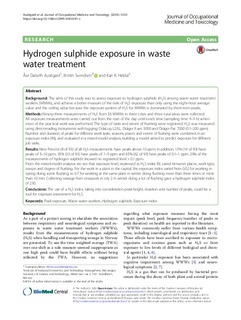| dc.contributor.author | Austigard, Åse Dalseth | |
| dc.contributor.author | Svendsen, Kristin V Hirsch | |
| dc.contributor.author | Heldal, Kari Emilie | |
| dc.date.accessioned | 2018-03-06T09:03:28Z | |
| dc.date.available | 2018-03-06T09:03:28Z | |
| dc.date.created | 2018-03-05T08:59:24Z | |
| dc.date.issued | 2018 | |
| dc.identifier.issn | 1745-6673 | |
| dc.identifier.uri | http://hdl.handle.net/11250/2488804 | |
| dc.description.abstract | Background
The aims of this study was to assess exposure to hydrogen sulphide (H2S) among waste water treatment workers (WWWs), and achieve a better measure of the risks of H2S exposure than only using the eight-hour average value and the ceiling value because the exposure pattern of H2S for WWWs is dominated by short-term peaks.
Methods
Ninety-three measurements of H2S from 56 WWWs in three cities and three rural areas were collected. All exposure measurements were carried out from the start of the day until lunch time (sampling time 4–5 h) when most of the practical work was performed. The type of tasks and extent of flushing were registered. H2S was measured using direct-reading instruments with logging: OdaLog L2/LL, Dräger X-am 5000 and Dräger Pac 7000 (0.1–200 ppm). Number and duration of peaks for different work tasks, seasons, places and extent of flushing were combined in an exposure index (IN), and evaluated in a mixed-model analysis, building a model aimed to predict exposure for different job tasks.
Results
Nine Percent (8 of 93) of all H2S measurements have peaks above 10 ppm; in addition, 15% (14 of 93) have peaks of 5–10 ppm, 35% (33 of 93) have peaks of 1–5 ppm and 65% (62 of 93) have peaks of 0.1–1 ppm. 29% of the measurements of hydrogen sulphide showed no registered level > 0.1 ppm.
From the mixed-model analyses we see that exposure level, expressed as H2S index IN, varied between places, work type, season and degree of flushing. For the work in a plant in the capital, the exposure index varied from 0.02 for working in spring doing some flushing, to 0.7 for working at the same plant in winter doing flushing more than three times or more than 10 min. Collecting sewage from cesspools in city 2 in winter doing a lot of flushing gave a hydrogen sulphide index of 230.
Conclusions
The use of a H2S index, taking into consideration peak height, duration and number of peaks, could be a tool for exposure assessment for H2S. | nb_NO |
| dc.language.iso | eng | nb_NO |
| dc.publisher | BioMed Central | nb_NO |
| dc.rights | Navngivelse 4.0 Internasjonal | * |
| dc.rights.uri | http://creativecommons.org/licenses/by/4.0/deed.no | * |
| dc.title | Hydrogen sulfide exposure in waste water treatment | nb_NO |
| dc.type | Journal article | nb_NO |
| dc.type | Peer reviewed | nb_NO |
| dc.description.version | publishedVersion | nb_NO |
| dc.source.volume | 13 | nb_NO |
| dc.source.journal | Journal of Occupational Medicine and Toxicology | nb_NO |
| dc.source.issue | 10 | nb_NO |
| dc.identifier.doi | https://doi.org/10.1186/s12995-018-0191-z | |
| dc.identifier.cristin | 1570377 | |
| dc.description.localcode | © The Author(s). 2018 Open Access This article is distributed under the terms of the Creative Commons Attribution 4.0 International License (http://creativecommons.org/licenses/by/4.0/) | nb_NO |
| cristin.unitcode | 194,60,25,0 | |
| cristin.unitname | Institutt for industriell økonomi og teknologiledelse | |
| cristin.ispublished | true | |
| cristin.fulltext | original | |
| cristin.qualitycode | 1 | |

